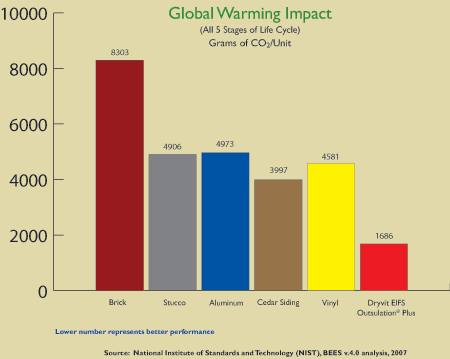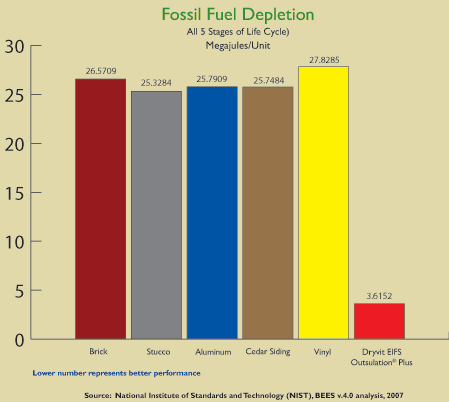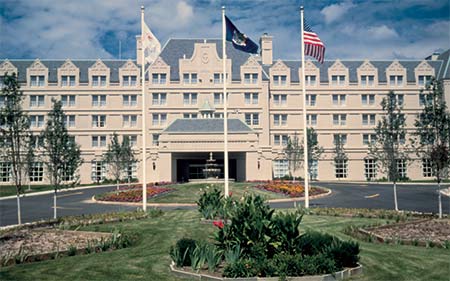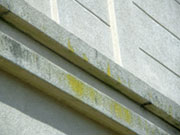 |
|
|
 |
Saving Energy With The Smallest Possible Footprint |
 |
The Life Cycle Advantages Of Dryvit Outsulation® Systems
Construction is one of the biggest businesses on the planet. Huge resources - financial and environmental
- go into the building industry. It is a $600 billion business in core investment alone.
There are three costs to consider when building today: the initial construction costs, the on-going operational costs, and the increasingly important environmental costs. By all three critical measures, Dryvit Outsulation systems represent the optimal cladding solution.
A case study developed by Nashville architects Lyman Davidson Dooley, determined that 10% of the shell construction costs could be saved on a building designed for masonry by substituting Dryvit's Outsulation system. More than $570,000 was saved in concrete, steel, cladding and HVAC by replacing heavier, less energy efficient materials with the Outsulation system.
The Oak Ridge National Laboratory also determined that Dryvit Outsulation systems are 84% more energy efficient than the next best cladding tested. That means Dryvit Outsulation systems can reduce a building's energy use by as much as 30%, year after year, saving both money and precious energy resources.
Finally, the National Institute of Standards and Technology (NIST) performed a full life cycle analysis of Dryvit Outsulation systems and found them to be more environmentally responsible than brick, stucco, aluminum, cedar and vinyl. Dryvit Outsulation systems have a smaller carbon footprint than other common claddings and offer a better green building alternative over the life of the project.
Our green philosophy is summarized by the phrase "tiny footprint, huge benefit." Our environmental impact is small, and the overall benefits of Dryvit Outsulation systems are huge. Less money to build and operate and an even smaller environmental cost equals the best exterior building solution on the planet today.
NIST: A Comprehensive Third-Party Analysis
Dryvit's contribution to savings through energy efficiency has long been
documented. But to be truly green, we needed to confirm that we used less energy in creating Outsulation systems than was saved by using them.
Supported by evidence provided through an analysis completed by NIST, one of the foremost government testing facilities, Dryvit can now confidently provide compelling data that details the overall environmental footprint of our systems, as compared with other common claddings, over the extended lifetime of a building.
Below are just two examples of critical findings from that research, which show clearly that when we refer to Dryvit Outsulation systems as green, this is indeed a statement of substance.
For full research findings, contact Dryvit at 1-800-556-7752, Extension 9.


EXTRACTION AND MANUFACTURING
MANUFACTURING FOR A HEALTHIER PLANET
Less fossil fuel burned = less CO2 produced.
Reduction of carbon dioxide emissions is a worldwide environmental goal.
Carbon dioxide is released into the atmosphere as a result of burning fossil fuels, and energy is necessary to extract and create the raw materials needed to manufacture Outsulation systems. Dryvit's overall environmental footprint, therefore, must take into account the environmental impact of the materials we use and the manufacturing processes we employ prior to delivering finished goods. The NIST study confirms that our results are comparable to most other claddings.
Dryvit is proud to have all five of its North American production facilities ISO
9001:2000 certified, which is the international standard for production quality and consistency as well as manufacturing efficiency.
Dryvit has also embarked upon an aggressive campaign to have all facilities certified to ISO 14000:2004 environmental standards, which will be completed by 2008. This commitment is an additional barometer of our overall environmental awareness and dedication to the proposition that a 21st century manufacturer must act responsibly as a steward of our environment.
TRANSPORTATION
LESS ENVIRONMENTAL IMPACT
Less CO2 produced = a cleaner environment..
It takes 16, fully loaded, tractor trailer trucks to move approximately 25,000 square feet of brick from the manufacturing location to the job site. Heavy transportation consumes a significant amount of diesel fuel, contributes significantly to the degradation of our nation's highway and bridge infrastructure, and requires more tires, batteries and other toxic environmental accessories.
For the same quantity of Dryvit Outsulation systems, a single truck is all that is required to get the material to the construction site. This means that the amount of fuel necessary to transport Dryvit Outsulation systems is less than 7% of that needed to haul brick over the same distance. It also means that as much as 16 times more CO2 is released into the atmosphere when equivalent square foot quantities of brick and Dryvit Outsulation systems are transported equal distances! Here's how all the products studied by NIST stack up:
CONSTRUCTION AND USE
SAVINGS OVER THE LIFETIME OF THE BUILDING
Lower construction costs
Less energy needed to heat and cool structures.
The initial savings achieved in the construction phase are reason enough to build with Dryvit Outsulation systems. A case study developed by the Nashville, TN architectural firm Lyman Davidson Dooley, Inc. determined that
- for a steel framed 52,896 square-foot medical office building
- the use of Dryvit Outsulation with Custom Brick™, Lymestone™ and TerraNeo® finishes substituted for traditional stone materials saved nearly 10% on a $5.74 million project.
However, the year-to-year energy savings (use) offer an even more positive environmental impact. The Oak Ridge National Laboratory (ORNL) found that walls clad with Dryvit's Outsulation systems are 84% more energy-efficient than other tested claddings, which can translate to a 20% to 30% average reduction in annual energy use for the building.
Explore the possibilities for yourself with the Dryvit Wall Wizard™ - a proprietary, web-based tool created specifically for Dryvit by ORNL. It is designed to help the user make location specific comparisons between the energy efficiency of Dryvit Outsulation systems and brick.
See Wall Wizard charts for Boston, Denver and San Antonio below:
REUSE
CREATED FOR SELF-PRESERVATION
The lasting benefits of DryvitCARE™
The cost-effective installation of Dryvit Outsulation systems is just the beginning of a lifetime of superior performance. DryvitCARE provides guidelines for cleaning, repair, and restoration of Dryvit Outsulation systems and will help facility managers keep their cladding looking good and performing exceptionally for the lifetime of the building.
Through completion of the Platinum Warranty program, the original system warranty is repeatedly eligible for renewal.
Properly maintained under the provisions of DryvitCARE, the Dryvit Outsulation systems will not need to be removed, recycled or put into a landfill. They will remain useful
- saving energy and helping protect our environment - for the lifetime of the building.

 This Hilton hotel, located in Pearl River, NY, exemplifies the benefits of DryvitCARE. The program helped this Hudson River valley hotel maintain its elegant, chateau-style exterior. This Hilton hotel, located in Pearl River, NY, exemplifies the benefits of DryvitCARE. The program helped this Hudson River valley hotel maintain its elegant, chateau-style exterior.
The Perfect Product To
Build Green and Save Green.
At Dryvit, being green is nothing new. Placing a seamless blanket of insulation on the exterior of the wall has been shown to be more energy efficient than other cladding assemblies for a long time. Since we introduced the Outsulation system to North America in 1969, millions of gallons of fossil fuel that might have been needed to heat and cool more than 400,000 buildings were saved, because these structures were clad with our systems. Today, tax and building Code changes recognize the contribution Dryvit Outsulation systems can make toward a cleaner, more environmentally efficient world.
The Life Cycle Analysis completed by NIST and recognized in their BEES 4.0e
(2007) software validates the fact that Dryvit Outsulation systems have a smaller carbon footprint than many other commonly used claddings.
Dryvit Outsulation systems - tiny footprint, huge benefit.
Maybe it's time to adjust your perspective?
|
|
 |
 |
 |
 |
 |
 |
 |
 |
 |
 |
Heating and Cooling
Heating and cooling account for about 56% of the energy use in a typical U.S. home
Click for more...
|
 |
 |
 |
 |
|
 |
 |
 |
 |
 |
 |
 |
 |
Dryvit Reducing Energy Use
By the end of this year, Dryvit Systems Inc. plans to have uniform policies and procedures in place to recycle paper, cardboard, batteries and light bulbs at each of its five North American locations.
Click for more...
|
 |
 |
 |
 |
|
| |
|
 |
